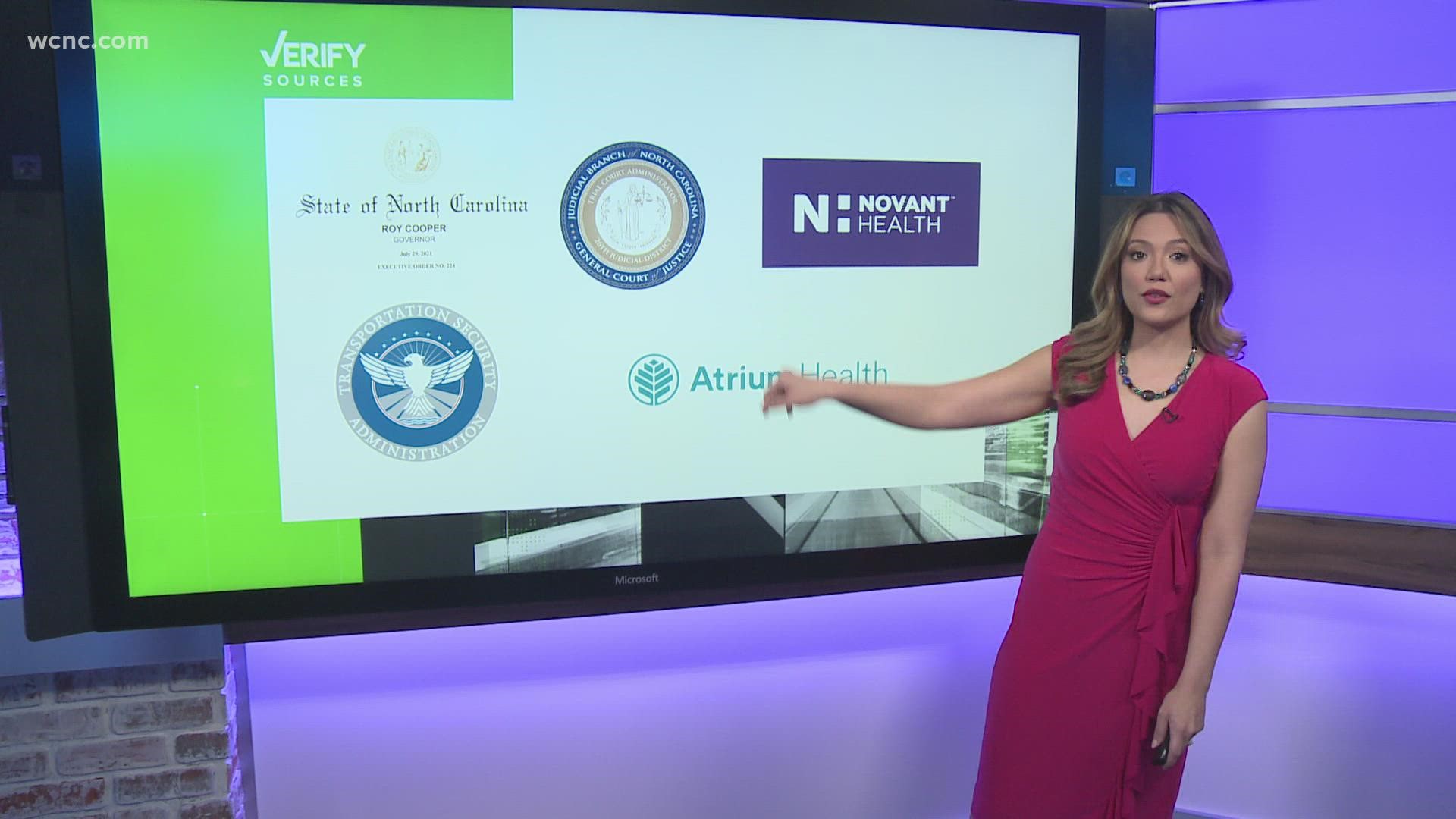LENOIR, N.C. — The Centers for Disease Control and Prevention (CDC) updated its COVID-19 guidance last week, putting a greater emphasis on hospitalizations and health care impacts over daily case counts while relaxing mask recommendations for most Americans.
Under the new CDC system, more than 70% of the U.S. population lives in counties where COVID-19 is posing a low or medium threat to hospitals. Those people can stop wearing masks, according to the CDC. However, officials are still advising people, including schoolchildren, to wear masks where the risk of COVID-19 is high.
That's the situation for about 37% of U.S. counties, including several in the Charlotte area.
The CDC is also offering a color-coded map — with counties designated as orange, yellow or green — to help guide local officials and residents. In green counties, local officials can drop any indoor masking rules. Yellow means people at high risk for severe disease should be cautious. Orange designates places where the CDC suggests masking should be universal.
How a county comes to be designated green, yellow or orange will depend on its rate of new COVID-19 hospital admissions, the share of staffed hospital beds occupied by COVID-19 patients and the rate of new cases in the community.
The new guidance from the CDC comes as COVID-19 cases continue to fall in the Carolinas. On Monday, North Carolina health officials announced 909 new cases. It was the first single-day case report below 1,000 since last July. The COVID-19 positivity rate is once again in the single digits and hospitalizations are down roughly 70% from their peak during the omicron surge earlier this year.
Several counties to the west of Mecklenburg County remain under "high" risk, including Gaston and Caldwell Counties.
However, Caldwell UNC Healthcare's Chief Medical Officer Dr. David Lowry said their hospitalizations have dropped significantly.
On Jan. 25, 60 of Caldwell UNC Healthcare's 137 beds were filled with COVID-19 patients, nearly all of them unvaccinated.
"We were overwhelmed," Lowry said. "More patients on ventilator breathing machines than we had ICU beds."
This week, they only had eight COVID-19 patients.
"People worked extra hours, extra shifts, and came together," Lowry said. "We've learned how to use medicines in the outpatient setting."
Gaston County's public health director Steve Eaton expects the CDC to upgrade the county to "medium" risk.
"We're excited about where we are," Eaton said. "I think that we still need to be cautious and aware when we're in large indoor group settings."
Dr. Shiddhi Patel is the assistant medical director for CaroMont Regional Medical Center's hospitalist group, and she said they're also seeing a sharp drop in COVID-19 patients.
"Most of the patients that come in are unvaccinated and have more of a severe hospital course," Patel said.
While Patel and Lowry expect conditions to continue to improve, Eaton cautioned the country is now transitioning from a "pandemic" to an "endemic," which means COVID-19 will become a "usual presence."
"We did not eradicate COVID nor will we," Eaton said. "COVID is going to be with us, but we're now going to be at a place where it's a usual presence."
All three healthcare leaders said vaccinations are critical to keeping hospitalizations down across the Carolinas.
In addition to the new map, the CDC says masks are no longer necessary on buses or vans operated by public or private school systems.
Lincoln County Schools announced Monday it would no longer require masks on buses despite the county exceeding the CDC's threshold for high community spread.
North Carolina counties in the Charlotte area with high COVID-19 levels
- None
South Carolina counties in the Charlotte area with high COVID-19 levels
- None
What to do if your county's community level is high
- Wear a mask indoors in public
- Stay up to date with COVID-19 vaccines
- Get tested if you have symptoms
- Take additional precautions if you are at high risk for severe illness
North Carolina counties in the Charlotte area with medium COVID-19 levels
- Watauga County
South Carolina counties in the Charlotte area with medium COVID-19 levels
- None
What to do if your county's community level is medium
- Talk to your health care provider about whether you need to wear a mask and other precautions if you are at high risk for severe illness
- Stay up to date with COVID-19 vaccines
- Get tested if you have symptoms
“Anybody is certainly welcome to wear a mask at any time if they feel safer wearing a mask,” CDC Director Dr. Rochelle Walensky said in a news briefing. “We want to make sure our hospitals are OK and people are not coming in with severe disease. ... Anyone can go to the CDC website, find out the volume of disease in their community and make that decision.”
What to do if your county's community level is low
- Stay up to date with COVID-19 vaccines
- Get tested if you have symptoms
WCNC Charlotte is part of seven major media companies and other local institutions reporting on and engaging the community around the problems and solutions as they relate to the COVID-19 pandemic. It is a project of the Charlotte Journalism Collaborative, which is supported by the Local Media Project, an initiative launched by the Solutions Journalism Network with support from the Knight Foundation to strengthen and reinvigorate local media ecosystems. See all of our reporting at charlottejournalism.org.


